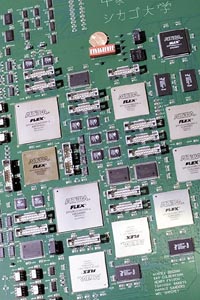Experiment allows Chicago team to help pursue ‘theory of everything’
Steve KoppesNews Office
Scientists may soon have an outside chance at solving a problem that consumed many of Albert Einstein’s final years. The problem: why is gravity trillions of times weaker than the other three fundamental forces operating in the universe?
 A team of University researchers, led by Henry Frisch and Melvyn Shochet, built some of the Collider Detector at Fermilab’s computer hardware (above). |
Chicago scientists and many of their colleagues have an advantage over Einstein in their search for an answer. They participate in the Collider Detector at Fermilab experiment, an international collaboration that uses the world’s most powerful subatomic particle accelerator to explore new territory in physics. Their ultimate goal is to experimentally verify a theory that would mathematically explain the motions of everything from stars and galaxies to subatomic particles.
Henry Frisch, Professor in Physics, and Melvyn Shochet, the Elaine and Samuel Kersten Jr. Professor in Physical Sciences, lead a Chicago team that helped build two critical components of the upgraded CDF. They begin plucking the fruits of their multi-year labor this month as CDF starts its second data run.
But even now, if the CDF collaboration is to find success where Einstein failed, “We have to be lucky,” Frisch said. “It’s possible it’s within reach. It’s much more likely it’s not within reach, but we’re in the game.”
The discovery of certain hypothetical particles would help incorporate gravity into a theory of everything for the physical world. Among other phenomena, Frisch will hunt for supersymmetric particles, Shochet for gravitons. But both types of particles may require more energy to create than Fermilab’s collider can muster.
Frisch describes supersymmetric particles as “mirror” particles to the ones that physicists have already observed. Stemming from supersymmetry theory, these particles would permit gravity to be as strong as the other three physical forces by extending the world into 10 tightly curled microscopic dimensions. These extra dimensions would absorb much of gravity’s force, unlike the electric force, for example, which operates in only three dimensions.
Frisch already has identified a particle collision in the last CDF data run that looks suspiciously like supersymmetry. There is less than a one in a million chance that the event was a statistical accident, but in the precision world of high-energy physics, one event does not make a discovery. “It’s intriguing, but it’s not yet that important,” Frisch said.
Nevertheless, the finding has led Frisch to frame a strategy that will help him and his colleagues eliminate even more uncertainty in the data as the search for supersymmetry progresses at CDF.
“We don’t really know what new we’re going to find, so let’s not look for anything new,” Frisch said. Instead, he has proposed looking carefully at phenomena that might hold new information and is rigorously calculating what they expect to find based on known physics, then checking to see if observations match expectations.
“Rather than specifically looking for purple cows with yellow horns, why don’t we just look at every cow that comes by and make sure that it really agrees with what we expect from a cow?” Frisch asked. “It requires a much better understanding of what you expect of normal cows. With that understanding, if there’s something new, we’ll find it.”
Physicists have almost as much chance of seeing a graviton, the particles that transmit gravity, as a real purple cow. Gravitons have never been observed, but if they were, it would give scientists a dramatic new way to view the universe. Just as X-rays and radio waves reveal a world far beyond the normal visual perception of humans, so would gravitons.
“It’s a long shot,” Shochet said. “By no means is it the most likely outcome. But it would be so startling if it were true that it’s important to look for.”
Physicists potentially could directly observe gravitons at CDF in the burst of particles resulting from a proton-antiproton collision. Failing that, gravitons might instead indirectly signal their presence by the influence they exert on other particles. Such effects might help advance Shochet’s effort to learn why certain elementary particles have mass.
Photons, the particles that transmit the light that allow humans to see the world around them, have no mass. But physicists have no reason to think that any particles should have mass, given their current understanding of nature’s laws.
“By far, the heaviest object we’ve seen is the top quark, which weighs almost 200 times as much as a hydrogen atom. It’s enormously heavy and we don’t know why that’s so,” Shochet said.
Shochet was co-spokesman for the CDF team that obtained the first direct experimental evidence for the top quark in 1994. Nevertheless, the properties of the top quark remain largely unknown because the old Tevatron produced less than 100 top quarks. The new Tevatron will produce top quarks hundreds of times more often, heralding a new era in high-energy physics research that even Einstein would have envied.
![[Chronicle]](/images/small-header.gif)